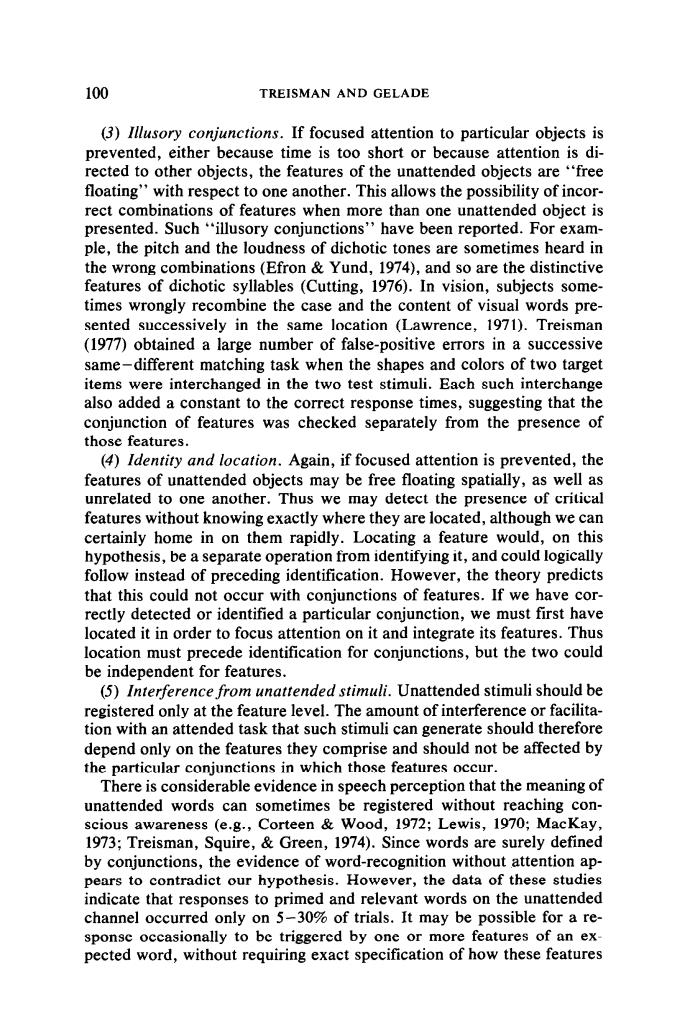正在加载图片...

100 TREISMAN AND GELADE (3)Illusory conjunctions.If focused attention to particular objects is prevented,either because time is too short or because attention is di- rected to other obiects.the features of the unattended obiects are"free floating''with respect to one another.This allows the possibility of incor- s of featr ure more than nattended c ed.Such conj ed.o ple,the pitch and the loudness of dichotic tones are sometimes heard in the wrong combinations (Efron Yund,1974),and so are the distinctive features of dichotic syllables (Cutting,1976).In vision,subjects some- times wrongly recombine the case and the content of visual words pre- tad essively in the same cation (Lawrence. 19710.Trei (1977)obtained a large number of false-positive errors in a successive same-different matching task when the shapes and colors of two target items were interchanged in the two test stimuli.Each such interchange also added a constant to the correct response times,suggesting that the conju nction of features was che cked separately from presence of (4)Identity and location.Again,if focused attention is prevented,the features of unattended objects may be free floating spatially,as well as unrelated to one another.Thus we may detect the presence of critical features without knowing exactly where they are located,although we can certai ly ho in them rap ng a fea thi hypothe esis,be a separa e ope could logicall follow instead of preceding identification.However,the theory predicts that this could not occur with conjunctions of features.If we have cor- rectly detected or identified a particular conjunction,we must first have located it in order to focus attention on it and integrate its features.Thus t pr ident tio n for conjunction: but the o could be independent for features. (5)Interference from unattended stimuli.Unattended stimuli should be registered only at the feature level.The amount of interference or facilita- tion with an attended task that such stimuli can generate should therefore ions in There is considerable evidence in speech perceptic n that the meaning of unattended words can sometimes be registered without reach ng con scious awareness (e.g.,Corteen Wood,1972;Lewis,1970;MacKay, 1973;Treisman,Squire,Green,1974).Since words are surely defined by conjunctions,the evidence of word-recognition without attention ap- ears tocontradict our hypothesis.However,the data of these studies ses to med and relevant w ords on the attended channel trials.It may he ible a re- spons lly to be triggered by on ex pected word,without requiring exact specification of how these features100 TREISMAN AND GELADE (3) Zllusory conjunctions. If focused attention to particular objects is prevented, either because time is too short or because attention is directed to other objects, the features of the unattended objects are “free floating” with respect to one another. This allows the possibility of incorrect combinations of features when more than one unattended object is presented. Such “illusory conjunctions” have been reported. For example, the pitch and the loudness of dichotic tones are sometimes heard in the wrong combinations (Efron & Yund, 1974), and so are the distinctive features of dichotic syllables (Cutting, 1976). In vision, subjects sometimes wrongly recombine the case and the content of visual words presented successively in the same location (Lawrence, 1971). Treisman (1977) obtained a large number of false-positive errors in a successive same-different matching task when the shapes and colors of two target items were interchanged in the two test stimuli. Each such interchange also added a constant to the correct response times, suggesting that the conjunction of features was checked separately from the presence of those features. (4) Identity and location. Again, if focused attention is prevented, the features of unattended objects may be free floating spatially, as well as unrelated to one another. Thus we may detect the presence of critical features without knowing exactly where they are located, although we can certainly home in on them rapidly. Locating a feature would, on this hypothesis, be a separate operation from identifying it, and could logically follow instead of preceding identification. However, the theory predicts that this could not occur with conjunctions of features. If we have correctly detected or identified a particular conjunction, we must first have located it in order to focus attention on it and integrate its features. Thus location must precede identification for conjunctions, but the two could be independent for features. (5) Interference from unattended stimuli. Unattended stimuli should be registered only at the feature level. The amount of interference or facilitation with an attended task that such stimuli can generate should therefore depend only on the features they comprise and should not be affected by the particular conjunctions in which those features occur. There is considerable evidence in speech perception that the meaning of unattended words can sometimes be registered without reaching conscious awareness (e.g., Corteen & Wood, 1972; Lewis, 1970; MacKay, 1973; Treisman, Squire, & Green, 1974). Since words are surely defined by conjunctions, the evidence of word-recognition without attention appears to contradict our hypothesis. However, the data of these studies indicate that responses to primed and relevant words on the unattended channel occurred only on 5-30% of trials. It may be possible for a response occasionally to be triggered by one or more features of an expected word, without requiring exact specification of how these features